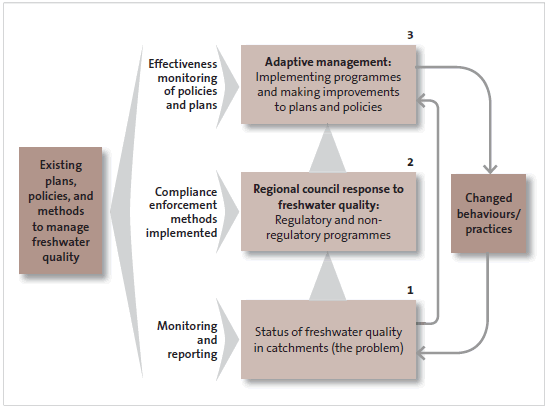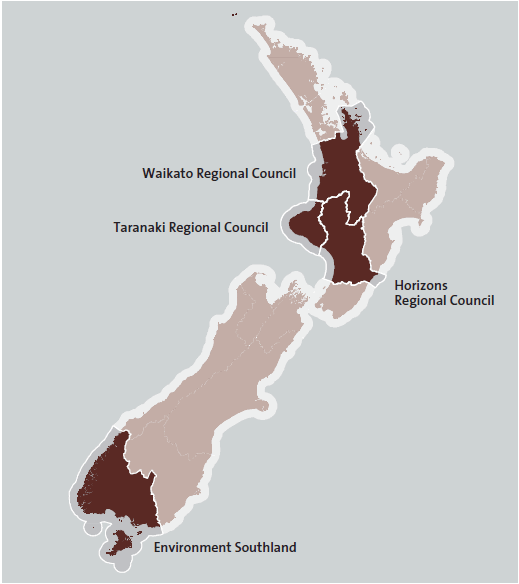Part 1: Introduction
1.1
In this Part, we discuss:
- the purpose of our audit;
- what we looked at;
- what we did not cover; and
- the structure of this report.
The purpose of our audit
1.2
We carried out an audit to provide an independent view of how effectively four selected regional councils are managing and controlling land use and related activities for the purpose of maintaining and enhancing freshwater quality in their regions.1 The applicable governing pieces of legislation are the Resource Management Act 1991 (the RMA) and the Government Act 2002 (the LGA).
1.3
There has been increasing Parliamentary and public interest in water during the last decade and concern about deteriorating freshwater quality – in particular about the cumulative effects of diffuse pollution, or "non-point source" discharges. Non-point source discharges contain nutrients (such as nitrogen and phosphorus), bacteria (such as E. coli), and sediment that reduce freshwater quality. When it rains, these contaminants are washed off land into lakes, rivers, or streams or absorbed into soil where they leach into groundwater. There are many sources of non-point source discharges (such as animal dung and urine, and fertiliser), which make them difficult to manage.
1.4
Given that non-point source discharges are a significant cause of declining freshwater quality, and that intensified land use is a significant source of those discharges, much of this report discusses how regional councils are managing the effects of intensified land use on freshwater quality. Although dairy farms are not the only source of non-point discharges (see Figure 3), we have largely considered how regional councils are managing non-point source discharges arising from dairy farming.
1.5
This latest audit builds on our 2005 audit,2 which looked at how two regional councils (Horizons and Otago) implemented a framework to manage freshwater quality and quantity in their regions. Our 2005 audit found that the councils had made good progress in planning and implementing water allocation frameworks, but needed to improve their compliance monitoring and measuring whether policies were having the desired effect.
1.6
In this 2011 audit, we focused specifically on water quality rather than quantity, and also examined the state of freshwater quality in each of the four regions. Our focus was on the effectiveness of approaches rather than legislative compliance. Figure 1 provides an overview of our audit model.
Figure 1
Assessing effectiveness of regional councils in maintaining and enhancing freshwater quality

What we looked at
1.7
We audited four regional councils: Waikato Regional Council, Taranaki Regional Council, Horizons Regional Council, and Environment Southland.
1.8
We selected the four regional councils based on:
- the extent and significance of surface water resources in the region;
- water quality trends and pressures; and
- whether there had been a regional water plan (either notified or operative) for a reasonable time (enabling us to assess progress towards the objectives and targets set in the plan).
1.9
Together, the four regional councils cover nearly one-third of New Zealand's total land area (see Figure 2).
Figure 2
The four regional council regions

Source: Land & Water New Zealand.
1.10
The Waikato region includes the country's longest river (the Waikato River) and largest lake (Lake Taupo). The Taranaki region is dominated by Mt Taranaki, the slopes of which give rise to more than 300 short but fast-flowing streams and rivers. Horizons Regional Council's region includes three major river systems (the Whanganui, the Rangitikei, and the Manawatu). The wet climate in the Southland region has required the installation of significant artificial drainage on pastoral land. Southland is also home to an internationally significant wetland.
1.11
The four regions have different sizes, topography, landscapes, soils, and river gradients. The historical quality of their freshwater, the degree to which land use has intensified, and the funding available to manage freshwater quality also varies. Communities' desires guide actions taken by regional councils to respond to freshwater quality concerns. The approaches taken to maintaining and enhancing freshwater quality in one region may not be enough or needed in another region.
1.12
To form a view on whether freshwater quality is being maintained and enhanced, we looked at whether the four regional councils:
- had a good understanding of the state of, and trends in freshwater quality in their regions;
- were responding appropriately and effectively to any deterioration in water quality;
- were improving their plans and policies in a timely manner; and
- whether their actions were improving freshwater quality.
1.13
We sought to identify examples of good practice to share with other regional councils and all those with an interest in managing freshwater quality.
1.14
To support our audit, we commissioned the National Institute of Water and Atmospheric Research Limited (NIWA) to advise us on the suitability of the scientific monitoring networks that the regional councils operate and on the state of, and trends in, freshwater quality in the four regions. NIWA's report, Freshwater quality monitoring by Environment Southland, Taranaki Regional Council, Horizons Regional Council and Environment Waikato, is available on our website (www.oag.govt.nz).
1.15
This report discusses matters arising from our audit of the four regional councils. It does not provide all our findings or a full discussion of all aspects of our audit. The audit covered the complete package of tools that regional councils use to manage freshwater quality – including the regulatory and non-regulatory programmes to manage soil erosion and riparian management to improve freshwater quality in rivers, lakes, wetlands, and groundwater.
What we did not cover
1.16
Although related to freshwater quality management and part of the context, we have excluded from the scope of this audit:
- central government policies on managing freshwater quality, because these were under review during the audit;
- water quantity issues, unless they relate directly to water quality in the selected catchments;
- the Canterbury region, because of the changing governance arrangements for freshwater quality management there; and
- the management of point source discharges and urban stormwater.
The structure of this report
1.17
In this report:
- Part 2 sets out the framework and context for managing freshwater quality.
- Part 3 discusses how regional councils monitor and report on freshwater quality and the pressures on it.
- Part 4 discusses how regional councils deal with the freshwater issues that arise.
- Part 5 discusses how regional councils take enforcement action under the RMA.
- Part 6 sets out examples of how regional councils share innovative practice.
- Appendix 1 provides a summary of our audit findings for the four regional councils.
- Appendix 2 is a self-assessment audit tool that councils can use to assess how well they are managing and enhancing freshwater quality.
- Appendix 3 sets out aspects of the RMA that councils use when managing freshwater quality.
- Appendix 4 sets out the freshwater quality variables, guidelines, and trigger values used in our freshwater quality analysis.
1.18
There is a Glossary at the end of this report.
1: Throughout this report, we summarise this as how effectively councils are "maintaining and enhancing" freshwater quality.
2: Controller and Auditor-General (2005), Horizons and Otago Regional Councils: Management of freshwater resources, Wellington.
page top
